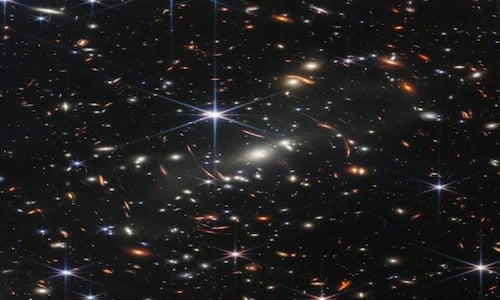
The James Webb Space Telescope (Webb) was launched into space on December 25, 2021, with high expectations. Scientists hoped the $10 billion space observatory would allow them to explore the origins of the Universe, its galaxies, and perhaps even the formation of the first stars. The initial photos, released by NASA on July 12, 2022, indicate that Webb is living up to its promise.
"Every image is a new discovery, and each will give humanity a view of the universe never seen before," NASA administrator Bill Nelson said before revealing the images at a press conference.
The deepest image of the Universe
President Joe Biden unveiled the first of Webb's debut images on July 11, 2022. The image is the deepest view of the Universe captured to date. The large white galaxies are part of the SMACS 0723 cluster, located in the Southern Hemisphere sky, about 5.12 billion light-years from Earth. It is the same age as the Sun and Earth. The faint red galaxies are believed to have formed 13.5 billion years ago, shortly after our Universe formed.
Stephan's Quintet
Stephan's Quintet lies in the Pegasus constellation, about 290 million light-years from Earth. It comprises five tightly-bound galaxies, each with as many as 100 billion stars. European Space Agency (ESA) astronomer Giovanna Giardino says the image shows "[four of the galaxies] locked in a sort of cosmic dance driven by gravitational force." Two of the galaxies appear to be in the process of merging.
Southern Ring Nebula
The Southern Ring Nebula is a figure eight-shaped cloud of gas and dust. Located about 2,500 light-years from Earth, it is the debris of a massive dying star. Scientists believe the dust particles could someday come together to form new stars or planets. Studying his kind of nebula will help researchers better understand how stars die and get reborn in the cosmos.
WASP-96b
WASP-96b is a massive exoplanet located about 1,120 light-years from Earth. The primarily gaseous planet boasts about half the mass of Jupiter. WASP-96b orbits so close to its star that a year on the planet equals just 3.4 Earth days. While the image reveals a large amount of water vapor in the planet's atmosphere, it is too hot to harbor life.
The Carina Nebula
Webb's powerful camera cut through dense clouds of dust and gas to capture a detailed image of the Carina Nebula. Located about 7,600 light-years from Earth in the southern constellation Carina, it is the most active star formation region known to scientists. The best-known is Eta Carinae. Estimated to be 100 times more massive than our Sun, it may be one of our galaxy's most massive stars.
Resources: NASA.gov, the conversation.com, Live Science.com.
